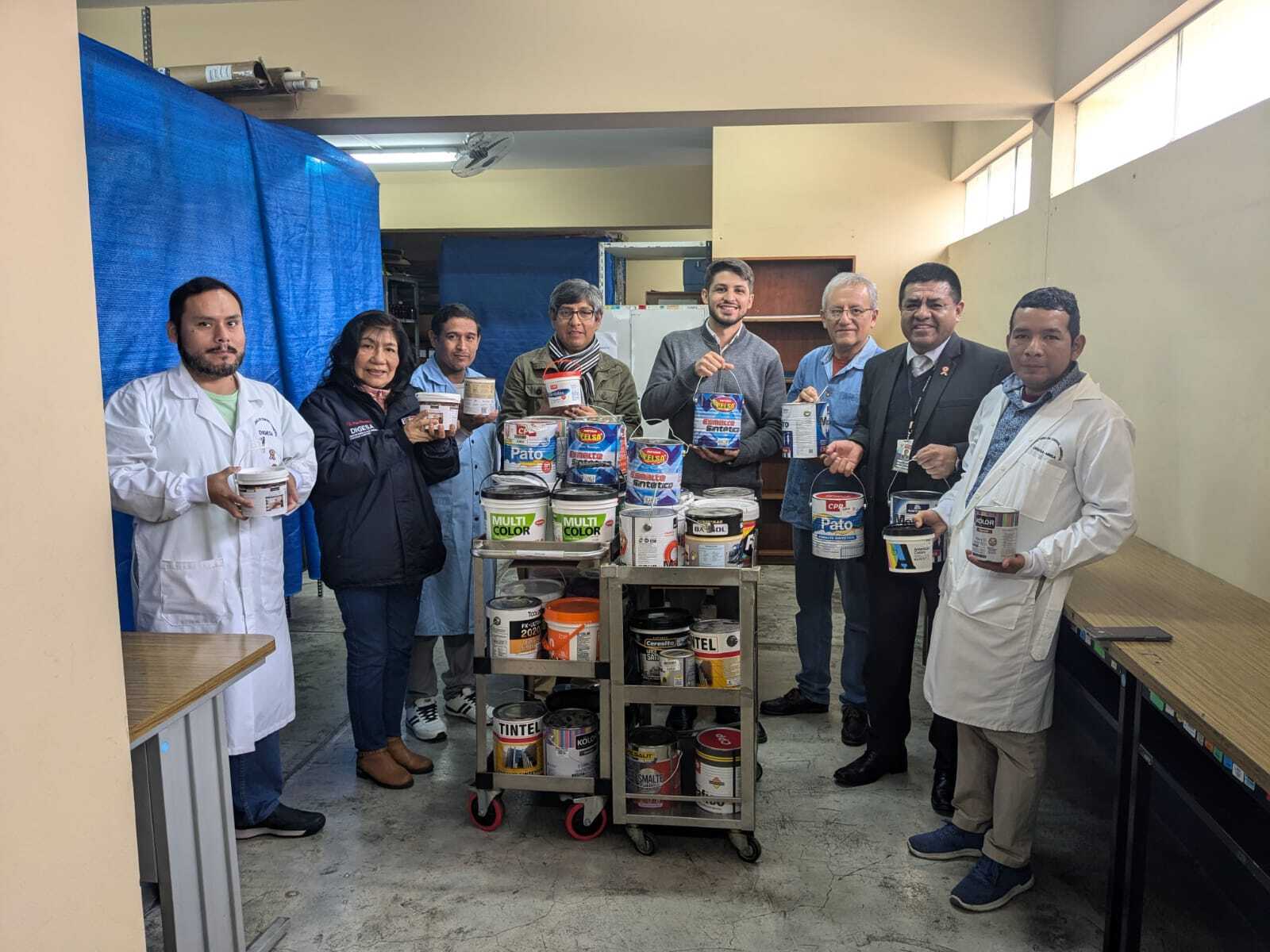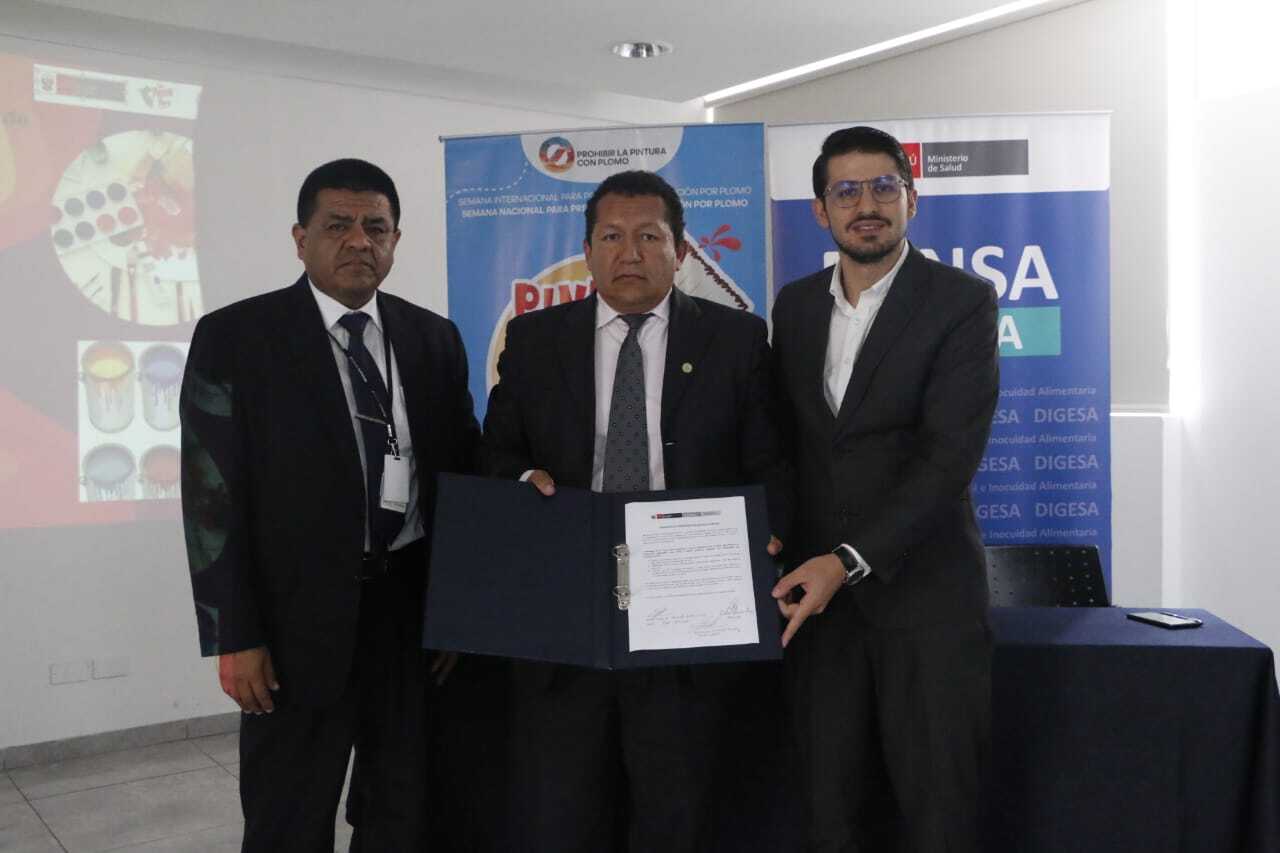Summary
- In October 2024, the General Directorate of Environmental Health and Food Safety (DIGESA), an agency of the Ministry of Health (MINSA), and LEEP conducted a paint study to assess the availability of lead paint on the market in Peru. The results showed that 16 out of the 55 samples purchased (29%) contained hazardous levels of lead (greater than 90 ppm).
- The study results were discussed at a multi-stakeholder workshop held in December 2024, which was attended by government officials, paint manufacturers, and public health advocates.
- Since the release of the study results, five of the largest lead paint manufacturers reported to LEEP that they are planning to reformulate to lead-free paint. Some manufacturers formalised this commitment by signing declarations to transition to lead-free formulations during the multi-stakeholder workshop.
Collaboration between MINSA/DIGESA and LEEP
In July 2024, MINSA/DIGESA and LEEP signed a Memorandum of Understanding to launch the project “Study and Collaboration on the Implementation of Lead Paint Regulations in Peru.” The initiative focuses on assessing health risks from lead in paints and strengthening regulations to protect public health. MINSA/DIGESA, as Peru’s National Health Authority, is leading this effort, working to implement activities to prevent lead exposure through paint, such as enhanced regulations and inspection capacities.
Paint study
In October 2024, MINSA/DIGESA and LEEP conducted a paint study to assess the availability of lead paint on the Peruvian market. The organisations tested paints sold in Lima to identify brands non-compliant with Peru’s lead paint law, Law No. 31182, which imposes a limit of 90 parts per million (ppm), and to indicate the extent to which paint is a source of lead exposure in the country.
The team bought 55 samples of solvent-based paints and water-based paints, from various stores in Lima, Peru. Where available, white, yellow, and red colours from each brand were purchased. If these colours were not available, similar colours were purchased. 22 brands were purchased in the study. All of the samples were from locally manufactured brands. 23 of the samples were from water-based paints and the remaining 32 were from solvent-based paints.
All paints were analysed by a laboratory at the University of Wisconsin, USA for lead content based on dry weight using inductively coupled plasma atomic emission spectrometry. The laboratory is accredited by the American Industrial Hygiene Association (AIHA) and it participates in the Environmental Lead Proficiency Analytical Testing program (ELPAT). The laboratory’s analytical methods and certifications are consistent with those recommended by the World Health Organisation for measuring lead in paint.

Representatives from the MINSA/DIGESA and LEEP teams conducting the paint study.
.
Results summary
The results showed that 16 out of the 55 samples (29%) contained hazardous levels of lead (greater than 90 ppm, which is the maximum level recommended by the WHO and UNEP, and which is the legal limit in Peru, according to Law No. 31182). All 16 of the lead paints were solvent-based paints. 10 of the lead paints were yellow, five were red and one white, indicating that lead pigments and sometimes also dryers are likely the source of the lead.
Most of the paints that contained lead had levels that significantly exceeded the 90 ppm limit. The highest lead content found was 130,000 ppm, which is more than 1,444 times higher than the limit.
Lead content of the 55 paint samples. 90 ppm is the maximum limit recommended by the WHO and UNEP.
Regulatory background and government activities
Peru already has a law which limits lead content in paints and coatings to 90 ppm, Law No. 31182, but the technical regulations which enable monitoring and enforcement activities are still pending approval by the Ministry of Economy and Finance (MEF) as well as the council of ministries.
Following the paint study results, MINSA/DIGESA began working to strengthen their inspection processes, enhance their technical team capacities, and adopt best practices for testing paints.
In early December 2024, MINSA/DIGESA and LEEP co-organised a multi-stakeholder workshop to present the study results to other government officials, manufacturers, and public health advocates. The workshop also covered the health impacts of lead exposure, the current lead paint law in Peru, and how manufacturers can remove lead from their paint.
Manfacturer engagement
Since the release of the study results, LEEP has engaged with four of the eight lead paint manufacturers sampled to offer technical assistance to reformulate their paint. During the study results workshop, these four manufacturers signed a declaration wherein they committed to reformulate their paints to lead-free, to adopt responsible production practices, to collaborate with authorities, to comply with Law No. 31182, and to thereby strengthen Peru’s lead-free paint sector. The declaration was also signed by a fifth manufacturer that was not tested, but was present at the event and confirmed that some of its paints had high levels of lead.
LEEP plans to engage with all lead paint manufacturers, including those who have not yet expressed a plan to transition to lead-free.

From left: Mr Elmer Quichiz Romero, a biologist at DIGESA, Dr. José Jorge Roncal Narváez, a representative from the Ministry of Health, and Dr Guillermo Olmedo Mendez, a Program Manager at LEEP, holding a signed manufacturer declaration at the December 2024 workshop.
Next steps
- LEEP will continue to collaborate with MINSA/DIGESA by helping them develop clear guidelines and enforcement mechanisms to ensure compliance with the lead paint regulation, once it is approved.
- LEEP will continue offering and providing technical support to manufacturers to reformulate their paints.
- LEEP will conduct follow-up testing to assess which manufacturers have successfully reformulated and support regulatory enforcement activity.
Acknowledgements
LEEP thanks the excellent teams at MINSA/DIGESA for their commitment to and partnership on this project.
Appendix
The following table shows the lead concentrations of the paints tested in the study:
| Brand | Type | Colour | Lead concentration (ppm) |
| Brand A | Oil/Solvent | Yellow | 19000 |
| Brand A | Oil/Solvent | White | <90 |
| Brand B | Oil/Solvent | Yellow | 24000 |
| Brand B | Oil/Solvent | White | <90 |
| Brand B | Oil/Solvent | Red | 12000 |
| Brand C | Oil/Solvent | White | <90 |
| Brand C | Oil/Solvent | Yellow | 27000 |
| Brand D | Oil/Solvent | Yellow | 15000 |
| Brand E | Water | White | <90 |
| Brand F | Water | White | <90 |
| Brand G | Water | Yellow | <90 |
| Brand G | Water | Red | <90 |
| Brand G | Water | White | <90 |
| Brand H | Water | White | <90 |
| Brand I | Water | White | <90 |
| Brand I | Oil/Solvent | Yellow | <90 |
| Brand I | Oil/Solvent | White | <90 |
| Brand I | Oil/Solvent | Red | 90* |
| Brand I | Oil/Solvent | Yellow | <90 |
| Brand J | Water | Red | <90 |
| Brand K | Oil/Solvent | Yellow | 6500 |
| Brand K | Water | Orange | <90 |
| Brand L | Oil/Solvent | Yellow | <90 |
| Brand L | Oil/Solvent | Red | <90 |
| Brand L | Oil/Solvent | White | <90 |
| Brand M | Oil/Solvent | Yellow | 110000 |
| Brand M | Oil/Solvent | White | <90 |
| Brand M | Oil/Solvent | Red | 16000 |
| Brand N | Oil/Solvent | Yellow | 41000 |
| Brand N | Oil/Solvent | White | <90 |
| Brand N | Oil/Solvent | Red | 280 |
| Brand N | Water | Yellow | <90 |
| Brand N | Water | White | <90 |
| Brand N | Water | Red | <90 |
| Brand O | Oil/Solvent | Yellow | 57000 |
| Brand O | Oil/Solvent | White | <90 |
| Brand O | Oil/Solvent | Red | 24000 |
| Brand P | Water | Yellow | <90 |
| Brand P | Water | White | <90 |
| Brand P | Water | Red | <90 |
| Brand Q | Oil/Solvent | White | 5000 |
| Brand R | Water | White | <90 |
| Brand B | Water | Yellow | <90 |
| Brand B | Water | White | <90 |
| Brand B | Water | Red | <90 |
| Brand S | Oil/Solvent | White | <90 |
| Brand S | Oil/Solvent | Red | <90 |
| Brand S | Oil/Solvent | Yellow | 24000 |
| Brand T | Oil/Solvent | Yellow | 130000 |
| Brand T | Oil/Solvent | White | <90 |
| Brand T | Oil/Solvent | Red | 36000 |
| Brand U | Water | Yellow | <90 |
| Brand U | Water | White | <90 |
| Brand U | Water | Red | <90 |
| Brand V | Water | White | <90 |
Lead concentrations of paints tested.
